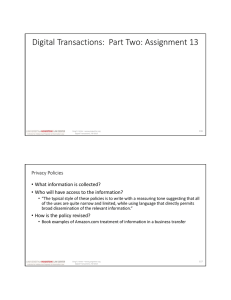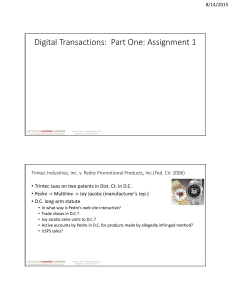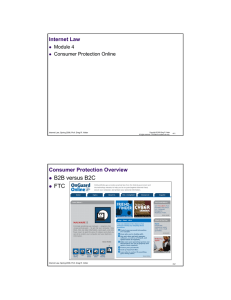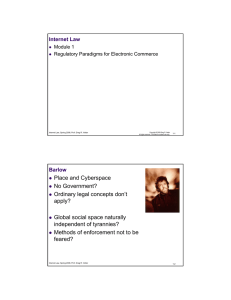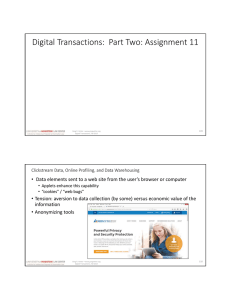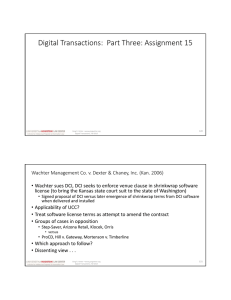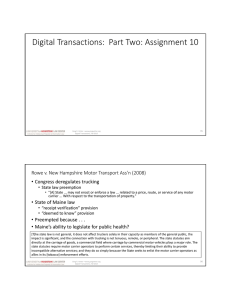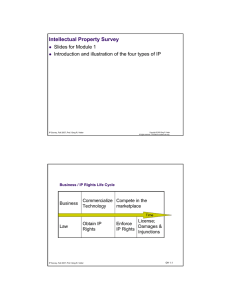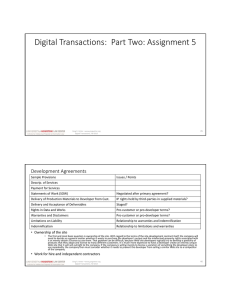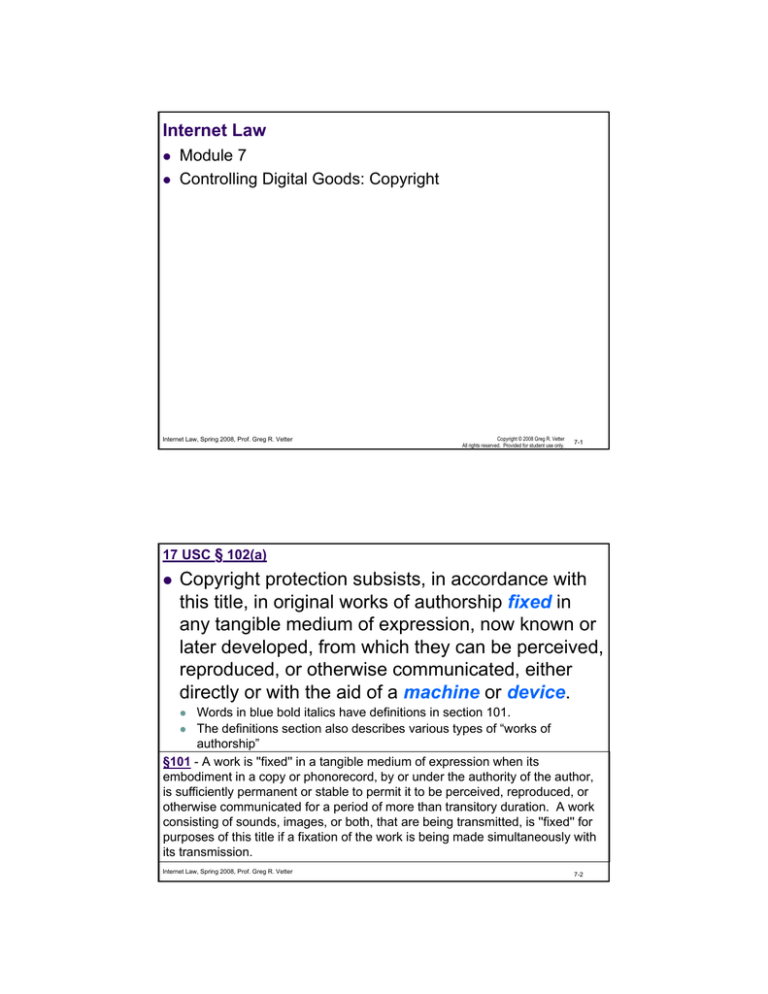
Internet Law
z
z
Module 7
Controlling Digital Goods: Copyright
Internet Law, Spring 2008, Prof. Greg R. Vetter
Copyright © 2008 Greg R. Vetter
All rights reserved. Provided for student use only.
7-1
17 USC § 102(a)
z
Copyright protection subsists, in accordance with
this title, in original works of authorship fixed in
any tangible medium of expression, now known or
later developed, from which they can be perceived,
reproduced, or otherwise communicated, either
directly or with the aid of a machine or device.
Words in blue bold italics have definitions in section 101.
z The definitions section also describes various types of “works of
authorship”
§101 - A work is ''fixed'' in a tangible medium of expression when its
embodiment in a copy or phonorecord, by or under the authority of the author,
is sufficiently permanent or stable to permit it to be perceived, reproduced, or
otherwise communicated for a period of more than transitory duration. A work
consisting of sounds, images, or both, that are being transmitted, is ''fixed'' for
purposes of this title if a fixation of the work is being made simultaneously with
its transmission.
z
Internet Law, Spring 2008, Prof. Greg R. Vetter
7-2
Idea-Expression Dichotomy
102(a)
Copyright protection subsists, in
accordance with this title, in original
works of authorship . . . [expression]
versus
102(b)
In no case does copyright protection for
an original work of authorship extend to
any idea, procedure, process, system,
method of operation, concept, principle,
or discovery, regardless of the form in
which it is described, explained,
illustrated, or embodied in such work.
[idea]
Internet Law, Spring 2008, Prof. Greg R. Vetter
7-3
Illustrative Works - § 102
literary works
1)
•
including non-literal elements such as structure, organization and sequence, but not
extending to names, titles and slogans; the less developed a literary character, the
less it can be copyrighted
musical works, including any accompanying words
dramatic works, including any accompanying music
pantomimes and choreographic works
2)
3)
4)
•
Protection extends to written or otherwise fixed instructions for performing a work of
art
pictorial, graphic, and sculptural works
5)
•
Useful article doctrine poses a significant limitation on the scope of protection; scope
of protection runs with degree to which author has delineated the subjects of the
work; In some cases, such as photographs, drawings and maps, the limited range of
expressive choices necessarily limits the scope of protection
motion pictures and other audiovisual works
sound recordings
architectural works
6)
7)
8)
•
New category after Berne implementation in US law; pictorial representations
permitted (if building visible from a public place); alterations and destruction allowed,
regardless of 106(2)
Internet Law, Spring 2008, Prof. Greg R. Vetter
7-4
Illustrative Works - § 102
1)
2)
3)
4)
5)
6)
7)
8)
literary works
musical works, including any accompanying words
•
Work must be original in its melody, harmony or rhythm, individually or in
combination.
•
But, rhythm is the least likely aspect in which originality may be manifested
•
Non-dramatic musical compositions are subject to a compulsory license once
released to the public – “cover license” under § 115
dramatic works, including any accompanying music
pantomimes and choreographic works
pictorial, graphic, and sculptural works
motion pictures and other audiovisual works
sound recordings
•
Since 1972, sound recordings are protectable independently of the musical,
dramatic, or literary works which are recorded; they are a separate work; does not
include sounds accompanying a motion picture or audiovisual work; no
mechanism such as the “cover license;” embodied in a “phonorecord”
•
No general public performance right
•
Sometimes not clear who the “author” of a sound recording is; singer, band, studio
engineer? – typically handled by contract
architectural works
Internet Law, Spring 2008, Prof. Greg R. Vetter
7-5
Illustrative Works - § 102
1)
2)
3)
4)
5)
6)
7)
8)
literary works
musical works, including any accompanying words
dramatic works, including any accompanying music
•
one that portrays a story by means of dialog or acting and [that] is intended to be
performed. It gives direction for performance or actually represents all or a
substantial portion of the action as actually occurring rather than merely being
narrated or described
pantomimes and choreographic works
pictorial, graphic, and sculptural works
motion pictures and other audiovisual works
•
AV works
•
series of related images which are intrinsically intended to be shown by the use
of machines . . . together with accompanying sounds, if any . . .
•
Motion pictures
•
A subset of AV works – “audiovisual works consisting of a series of related
images which, when shown in succession, impart an impression of motion,
together with accompanying sounds, if any”
sound recordings
architectural works
Internet Law, Spring 2008, Prof. Greg R. Vetter
7-6
Derivative Works; Compilations
z
z
z
z
is “based upon one or more preexisting works . . . [and is any] form in
which a work may be recast, transformed, or adapted”
Examples include:
z translation, musical arrangement, dramatization, fictionalization, motion
picture version, sound recording, art reproduction, abridgment,
condensation
z a work consisting of editorial revisions, annotations, elaborations, or other
modifications which, as a whole, represent an original work of authorship
Why have derivative works protection?
z Chain of products; new expression from public domain materials; different
markets & licensing
Compilations
z a work formed by the collection and assembling of preexisting materials
or of data that are selected, coordinated, or arranged in such a way that
the resulting work as a whole constitutes an original work of authorship.
The term ''compilation'' includes collective works
Internet Law, Spring 2008, Prof. Greg R. Vetter
7-7
Exclusive Rights in © Works - § 106
z
Subject to sections 107 through 121, the owner of copyright under this title
has the exclusive rights to do and to authorize any of the following:
z
z
z
z
z
z
(1) to reproduce the copyrighted work in copies or phonorecords
[material object in which sound is fixated . . .];
(2) to prepare derivative works based upon the copyrighted work;
(3) to distribute copies or phonorecords of the copyrighted work to
the public by sale or other transfer of ownership, or by rental,
lease, or lending;
(4) in the case of literary, musical, dramatic, and choreographic
works, pantomimes, and motion pictures and other audiovisual
works, to perform the copyrighted work publicly;
(5) in the case of literary, musical, dramatic, and choreographic
works, pantomimes, and pictorial, graphic, or sculptural works,
including the individual images of a motion picture or other
audiovisual work, to display the copyrighted work publicly; and
(6) in the case of sound recordings, to perform the copyrighted
work publicly by means of a digital audio transmission
Internet Law, Spring 2008, Prof. Greg R. Vetter
7-8
For digital content, there is copying . . .
z
z
z
z
z
z
z
When a work is placed into a computer, whether on a disk, diskette,
ROM, or other storage device or in RAM for more than a very brief
period, a copy is made.
When a printed work is "scanned" into a digital file, a copy -- the digital
file itself -- is made.
When other works -- including photographs, motion pictures, or sound
recordings – are digitized, copies are made.
Whenever a digitized file is "uploaded" from a user's computer to a
bulletin board system (BBS) or other server, a copy is made.
Whenever a digitized file is "downloaded" from a BBS or other server, a
copy is made.
When a file is transferred from one computer network user to another,
multiple copies generally are made.
Under current technology, when an end-user's computer is employed as
a "dumb" terminal to access a file resident on another computer such as
a BBS or Internet host, a copy of at least the portion viewed is made in
the user's computer. Without such copying into the RAM or buffer of the
user's computer, no screen display would be possible
See http://www.uspto.gov/web/offices/com/doc/ipnii/ipnii.pdf at 65-66
Internet Law, Spring 2008, Prof. Greg R. Vetter
7-9
Distribution Right
z
§ 106(3):
z
z
“Subject to sections 107 through 121, the owner of copyright under
this title has the exclusive rights to do and to authorize any of the
following: . . .
z to distribute copies or phonorecords of the copyrighted work to the
public by sale or other transfer of ownership, or by rental, lease, or
lending”
“First sale” doctrine - § 109(a):
z
“the owner of a particular copy or phonorecord lawfully made
under this title, or any person authorized by such owner, is
entitled, without the authority of the copyright owner, to sell or
otherwise dispose of the possession of that copy or phonorecord.”
z But, § 109(a) does not apply to the rental of phonorecords or
computer programs for profit. See § 109(b)
Internet Law, Spring 2008, Prof. Greg R. Vetter
7-10
Public Performance and Display Rights
z
z
§ 101 - to ''display'' a work means to show a
copy of it, either directly or by means of a film,
slide, television image, or any other device or
process or, in the case of a motion picture or
other audiovisual work, to show individual
images nonsequentially
§ 101 - to ''perform'' a work means to recite,
render, play, dance, or act it, either directly or
by means of any device or process or, in the
case of a motion picture or other audiovisual
work, to show its images in any sequence or
to make the sounds accompanying it audible
Internet Law, Spring 2008, Prof. Greg R. Vetter
7-11
Public Performance and Display Rights
z
z
If it moves, it’s a performance; if its stays still, it’s
a display
§ 101 - to perform or display a work ''publicly''
means –
z
(1) to perform or display it at a place
z
z
z
open to the public or
at any place where a substantial number of persons
outside of a normal circle of a family and its social
acquaintances is gathered; or
(2) to transmit or otherwise communicate a
performance or display of the work to a place
specified by clause (1) or to the public, by means of
any device or process, whether the members of the
public capable of receiving the performance or
display receive it in the same place or in separate
places and at the same time or at different times.
Internet Law, Spring 2008, Prof. Greg R. Vetter
7-12
§ 109(d)
z
The privileges prescribed by subsections
z 109(a) [first sale doctrine] and
z 109(c) [limitation on the display right]
z do not, unless authorized by the copyright
owner, extend to any person who has
acquired possession of the copy or
phonorecord from the copyright owner, by
rental, lease, loan, or otherwise, without
acquiring ownership of it.
Internet Law, Spring 2008, Prof. Greg R. Vetter
7-13
Public Performance & Display Rights (& others)
A work of mixed fine art lawfully
purchased by a professor
A line of poetry
A 2d line of
poetry
A 3rd line of
poetry
Make cards w/ the poetry
ora
po t e t h
e
pu t r y i e
blic n
Using a camera
aimed at the
bulletin board,
broadcast an
image of the art
Sell the
cards
Post on
bulletin board
outside office
z
Copy on a copier
Sell the
copies
Considering section 109, but ignoring any other possible exemptions
arising from sections 107 through 121, which actions infringe which
rights?
Internet Law, Spring 2008, Prof. Greg R. Vetter
7-14
Fair Use
z
z
z
z
Notwithstanding the provisions of sections 106 and 106A, the fair use
of a copyrighted work,
z including such use by reproduction in copies or phonorecords or by
any other means specified by that section,
for purposes such as criticism, comment, news reporting, teaching
(including multiple copies for classroom use), scholarship, or
research, is not an infringement of copyright.
In determining whether the use made of a work in any particular case
is a fair use the factors to be considered shall include z (1) the purpose and character of the use, including whether such use
is of a commercial nature or is for nonprofit educational purposes;
z (2) the nature of the copyrighted work;
z (3) the amount and substantiality of the portion used in relation to the
copyrighted work as a whole; and
z (4) the effect of the use upon the potential market for or value of the
copyrighted work.
The fact that a work is unpublished shall not itself bar a finding of fair
use if such finding is made upon consideration of all the above factors
Internet Law, Spring 2008, Prof. Greg R. Vetter
7-15
Reese – Fundamentals of Digital Music ©
z
Reproduction Right
z
z
z
z
z
Musical Work versus Sound Recording
17 USC §115 – “compulsory mechanical
license”
1995 – enter the DPD
Performance Right
Sound Recordings
z
z
No performance right until . . .
Digital Transmission Performance Right
Internet Law, Spring 2008, Prof. Greg R. Vetter
7-16
Fundamentals of Digital Music ©
z
Digital Transmission Performance Right (DTPR) – types
and limitations
z
z
Interactive service “celestial jukebox”
z Need permission from DTPR owner
Non-interactive
z Non-subscription broadcast (terrestrial)
z
Non-interactive transmissions other than broadcast qualifying for
DTPR compulsory license
z
z
z
exempt from DTPR
need permission for musical work public performance
Not applicable to internet simulcasts
Compulsory license of the DTPR (long list of detailed conditions)
Hypothetical web site: WebJazz
Non-interactive transmissions not qualifying for DTPR compulsory
license
“incidental” DPDs
Streaming, temporary storage, and reproduction
Internet Law, Spring 2008, Prof. Greg R. Vetter
7-17
UMG Recordings v. MP3.com (SDNY.2000)
z
z
z
z
z
z
How did My.MP3.com service work?
z “Beam-it Service”
z “instant Listening Service”
(1) the purpose and character of the use, including whether such use is
of a commercial nature or is for nonprofit educational purposes
z Court found it commercial
z “space shift” transformation?
(2) the nature of the copyrighted work
z “core” of copyright
(3) the amount and substantiality of the portion used in relation to the
copyrighted work as a whole
z entirety
(4) the effect of the use upon the potential market for or value of the
copyrighted work
z Negative or positive effects on P’s markets?
(other) – Consumer Protection
z Relation to characterization of purpose of copyright?
Internet Law, Spring 2008, Prof. Greg R. Vetter
7-18
Reese – Downloads
z
Who makes the reproduction?
z
z
z
User
Web site
Both a reproduction and a public performance?
z
z
Transaction cost implications in arrangements between
site operator and right(s)-holder(s)
Copyright office view
Internet Law, Spring 2008, Prof. Greg R. Vetter
7-19
A&M Records v. Napster (9th.2001)
z
z
z
z
Collective directory to show availability of currently
connected client computers
Uploading file names violates
distribution right
Downloading files violates
reproduction right
Fair Use?
z
Purpose & character
z
z
z
z
z
Not transformative
Commercial
Nature of the work
Amount used
Effect on market
Internet Law, Spring 2008, Prof. Greg R. Vetter
7-20
RIAA v. Diamond Multimedia (9th.1999)
DARDs need the SCMS
z
A “digital audio recording device” is any machine or device of a
type commonly distributed to individuals for use by individuals,
whether or not included with or as part of some other machine
or device, the digital recording function of which is designed or
marketed for the primary purpose of, and that is capable of,
making a digital audio copied recording for private use . . .
z
z
z
To be a DARD, “the Rio must be able to
reproduce, either ‘directly’ or ‘from a
transmission,’ a ‘digital music recording.’”
Directly?
z Hard drives don’t contain “only” sounds, and
do contain computer programs, and thus aren’t
a “material object” containing a ‘digital music
recording’
From a Transmission?
Internet Law, Spring 2008, Prof. Greg R. Vetter
7-21
Secondary Liability – ISPs
Religious Tech. Ctr. v. Netcom (ND.Cal.1995)
z
z
z
BBS/ISP liable for copyright infringement of BBS
subscriber?
Rights holder is RTC, L. Ron Hubbard works
related to Scientology
Direct
z
Volition or causation
by Netcom?
z
z
Or, are contributing actions
“automatic and indiscriminate”
Mere conduit?
Internet Law, Spring 2008, Prof. Greg R. Vetter
7-22
Secondary Liability – ISPs
Religious Tech. Ctr. v. Netcom (ND.Cal.1995)
z
Contributory
z
z
Situations where knowledge might not be found
z
z
z
z
w/ knowledge = Knew or Should Have Known (KorSHK)
Colorable claim of fair use
No copyright notices
Insufficient documentation
from P
Substantial participation
z
z
Compare to leasing premises?
“fair” to impose liability
assuming simple preventive
measures are available
Internet Law, Spring 2008, Prof. Greg R. Vetter
7-23
Secondary Liability – ISPs
Religious Tech. Ctr. v. Netcom (ND.Cal.1995)
z
z
Vicarious
Right and ability to control
z
z
z
z
Direct financial benefit
z
z
z
User terms
netiquette
Suspend accounts?
Proportional or fixed fees
Erlich’s infringement doesn’t
enhance value/profit of
Netcom’s services
First Amendment / Fair Use
Internet Law, Spring 2008, Prof. Greg R. Vetter
7-24
ISP Safe Harbors - Ellison v. Robertson (9th.2004)
z
z
Robertson scanning Harlan Ellison sci-fi works
Traveling through Usenet, messages passed
through AOL
z
z
z
z
Messages contain non-authorized scanned portions of
Ellison’s books
AOL failure to keep contact email updated
Can a reasonably implemented policy against
repeat infringers contain a faulty notice
mechanism?
If not, impact on the service provider?
Internet Law, Spring 2008, Prof. Greg R. Vetter
7-25
17 U.S.C. 512(a)
(a) Transitory digital network communications.--A service provider shall not be liable for
monetary relief, or, except as provided in subsection (j), for injunctive or other equitable relief, for
infringement of copyright by reason of the provider's transmitting, routing, or providing connections
for, material through a system or network controlled or operated by or for the service provider, or by
reason of the intermediate and transient storage of that material in the course of such transmitting,
routing, or providing connections, if-(1) the transmission of the material was initiated by or at the direction of a person other than the
service provider;
(2) the transmission, routing, provision of connections, or storage is carried out through an
automatic technical process without selection of the material by the service provider;
(3) the service provider does not select the recipients of the material except as an automatic
response to the request of another person;
(4) no copy of the material made by the service provider in the course of such intermediate or
transient storage is maintained on the system or network in a manner ordinarily accessible to
anyone other than anticipated recipients, and no such copy is maintained on the system or network
in a manner ordinarily accessible to such anticipated recipients for a longer period than is
reasonably necessary for the transmission, routing, or provision of connections; and
(5) the material is transmitted through the system or network without modification of its content.
Internet Law, Spring 2008, Prof. Greg R. Vetter
7-26
17 U.S.C. 512(b)-(d) in part . . .
(b) System caching.-(1) Limitation on liability.--A service provider shall not be liable for monetary relief, or, except as provided
in subsection (j), for injunctive or other equitable relief, for infringement of copyright by reason of the
intermediate and temporary storage of material on a system or network controlled or operated by or for
the service provider in a case in which-(A) the material is made available online by a person other than the service provider;
(B) the material is transmitted from the person described in subparagraph (A) through the system or
network to a person other than the person described in subparagraph (A) at the direction of that other
person; and
(C) the storage is carried out through an automatic technical process for the purpose of making the
material available to users of the system or network who, after the material is transmitted as described in
subparagraph (B), request access to the material from the person described in subparagraph (A), if the
conditions set forth in paragraph (2) are met. . . .
(c) Information residing on systems or networks at direction of users.-(1) In general.--A service provider shall not be liable for monetary relief, or, except as provided in
subsection (j), for injunctive or other equitable relief, for infringement of copyright by reason of the
storage at the direction of a user of material that resides on a system or network controlled or
operated by or for the service provider, if the service provider-- . . . .
(d) Information location tools.--A service provider shall not be liable for monetary relief, or,
except as provided in subsection (j), for injunctive or other equitable relief, for infringement of
copyright by reason of the provider referring or linking users to an online location containing
infringing material or infringing activity, by using information location tools, including a directory,
index, reference, pointer, or hypertext link, if the service provider-- . . .
Internet Law, Spring 2008, Prof. Greg R. Vetter
7-27
Ellison v. Robertson (CD.Cal.2004)
z
Robertson scanning Harlan Ellison sci-fi works
Traveling through Usenet, messages passed
through AOL
z
§512(a) – no “takedown”, but “service provider is
z
narrowed
z
z
z
(a) and (k) definitions for limited/narrowed service provider
can be analyzed as one
Are Usenet message copies “intermediate and transient
storage” (§512(a)(4)) if they sit on AOL’s servers for 14 days
. . . versus
z Email or Internet connectivity
z Hosting a web site or chatroom
Internet Law, Spring 2008, Prof. Greg R. Vetter
7-28
A&M Records v. Napster (ND.Cal.2000)
z Does the §512(a) safe harbor
apply to Napster system?
z What is the Napster system?
z
z
z
z
z
z
Napster browsers
User computers
Is the Internet part of the Napster
system?
Is a transmission from a user
computer to another user
computer a transfer “through” the
Napster system?
§512(a): A service provider shall not be liable for monetary
A “routing”?
relief . . . for infringement of copyright by reason of the
provider's transmitting, routing, or providing connections for,
A “connection”?
material through a system or network controlled or operated
by or for the service provider
Internet Law, Spring 2008, Prof. Greg R. Vetter
7-29
17 U.S.C. 512(c)
(c) Information residing on systems or networks at direction of users.-(1) In general.--A service provider shall not be liable for monetary relief, or, except as
provided in subsection (j), for injunctive or other equitable relief, for infringement of
copyright by reason of the storage at the direction of a user of material that resides on a
system or network controlled or operated by or for the service provider, if the service
provider-(A)(i) does not have actual knowledge that the material or an activity using the material
on the system or network is infringing;
(ii) in the absence of such actual knowledge, is not aware of facts or circumstances from
which infringing activity is apparent; or
(iii) upon obtaining such knowledge or awareness, acts expeditiously to remove, or
disable access to, the material;
(B) does not receive a financial benefit directly attributable to the infringing activity, in a
case in which the service provider has the right and ability to control such activity; and
(C) upon notification of claimed infringement as described in paragraph (3), responds
expeditiously to remove, or disable access to, the material that is claimed to be infringing
or to be the subject of infringing activity.
(2) Designated agent.--The limitations on liability established in this subsection apply to
a service provider only if the service provider has designated an agent to receive
notifications of claimed infringement described in paragraph (3) . . .
Internet Law, Spring 2008, Prof. Greg R. Vetter
7-30
17 U.S.C. 512(c)
(c) Information residing on systems or networks at direction of users.—
...
(3) Elements of notification.-(A) To be effective under this subsection, a notification of claimed infringement must be a written communication
provided to the designated agent of a service provider that includes substantially the following:
(i) A physical or electronic signature of a person authorized to act on behalf of the owner of an
exclusive right that is allegedly infringed.
(ii) Identification of the copyrighted work claimed to have been infringed, or, if multiple copyrighted
works at a single online site are covered by a single notification, a representative list of such works at that site.
(iii) Identification of the material that is claimed to be infringing or to be the subject of infringing
activity and that is to be removed or access to which is to be disabled, and information reasonably sufficient to
permit the service provider to locate the material.
(iv) Information reasonably sufficient to permit the service provider to contact the complaining party,
such as an address, telephone number, and, if available, an electronic mail address at which the complaining
party may be contacted.
(v) A statement that the complaining party has a good faith belief that use of the material in the
manner complained of is not authorized by the copyright owner, its agent, or the law.
(vi) A statement that the information in the notification is accurate, and under penalty of perjury, that
the complaining party is authorized to act on behalf of the owner of an exclusive right that is allegedly infringed.
(B)
(i) Subject to clause (ii), a notification from a copyright owner or from a person authorized to act on
behalf of the copyright owner that fails to comply substantially with the provisions of subparagraph (A) shall not
be considered under paragraph (1)(A) in determining whether a service provider has actual knowledge or is
aware of facts or circumstances from which infringing activity is apparent.
(ii) In a case in which the notification that is provided to the service provider's designated agent fails
to comply substantially with all the provisions of subparagraph (A) but substantially complies with clauses (ii),
(iii), and (iv) of subparagraph (A), clause (i) of this subparagraph applies only if the service provider promptly
attempts to contact the person making the notification or takes other reasonable steps to assist in the receipt of
notification that substantially complies with all the provisions of subparagraph (A).
Internet Law, Spring 2008, Prof. Greg R. Vetter
7-31
ALS Scan v. RemarQ Communities (4th.2001)
z
Newsgroups on RemarQ ISP servers
z
z
z
z
z
Letter by ALS, response by RemarQ
What statutory provision anchors whether or not
RemarQ is in the safe harbor?
What statutory provision feeds into the anchor
provision?
z
z
alt.binaries.pictures.erotica.als
User postings of ALS’s copyright protected pictures
What clauses are at issue?
What degree of notice compliance is required?
What degree of notice did ALS give?
Internet Law, Spring 2008, Prof. Greg R. Vetter
7-32
Hendrickson v. Amazon.com (CD.Cal.2003)
z
z
z
What is the direct copyright
infringement activity?
Notification: all Manson DVDs are
unauthorized
How long does an adequate notice
remain viable?
z
z
Present tense statutory language
Does Amazon.com qualify for S/H?
z
z
Notice Scope
z
No notice due to §512(c)(3)(B) impact on §512(c)(1)(A)
§512(c)(1)(B) – financial benefit and control
§512(c)(1)(C) – take it down?
A rule, or even a
standard, might suffice;
a listing, however,
is most specific
“evergreen” notices??
Time
Internet Law, Spring 2008, Prof. Greg R. Vetter
7-33
Intellectual Reserve v. Utah Lighthouse Ministry
(D.Utah.1999)
z
z
D, Utah Lighthouse
Ministry, posted Handbook
After takedown, web site content contained
z
z
z
z
z
Statements that Handbook is available elsewhere
online: “Church Handbook of Instructions is back
online!”
3 web site addresses as to where
Posted emails encouraging traffic to these, and
distribution of Handbook found there
Are browsing users to 3 locations direct infringers?
Outcome against preliminary injunction standard?
Internet Law, Spring 2008, Prof. Greg R. Vetter
7-34
17 U.S.C. 512(d)
(d) Information location tools.--A service provider shall not be liable for monetary relief, or,
except as provided in subsection (j), for injunctive or other equitable relief, for infringement of
copyright by reason of the provider referring or linking users to an online location containing
infringing material or infringing activity, by using information location tools, including a directory,
index, reference, pointer, or hypertext link, if the service provider-(1)
(A) does not have actual knowledge that the material or activity is infringing;
(B) in the absence of such actual knowledge, is not aware of facts or circumstances from
which infringing activity is apparent; or
(C) upon obtaining such knowledge or awareness, acts expeditiously to remove, or
disable access to, the material;
(2) does not receive a financial benefit directly attributable to the infringing activity, in a case in
which the service provider has the right and ability to control such activity; and
(3) upon notification of claimed infringement as described in subsection (c)(3), responds
expeditiously to remove, or disable access to, the material that is claimed to be infringing or to be
the subject of infringing activity, except that, for purposes of this paragraph, the information
described in subsection (c)(3)(A)(iii) [_identify w/ sufficiently specific information to locate_] shall be
identification of the reference or link, to material or activity claimed to be infringing, that is to be
removed or access to which is to be disabled, and information reasonably sufficient to permit the
service provider to locate that reference or link.
Internet Law, Spring 2008, Prof. Greg R. Vetter
7-35
Perfect 10 v. CCBill (CD.Cal.2004)
z
Among various Ds is Internet Key’s “SexKey” age
verification system for adult web sites
z
Is the facility provided by the age verification
system an Information Location Tool?
z
§512(d)(1) - Knowledge?
z
§512(d)(2)
z
z
Direct financial benefit?
Right and ability to control infringing activity?
Internet Law, Spring 2008, Prof. Greg R. Vetter
7-36
17 U.S.C. 512(k)
(k) Definitions.-(1) Service provider.--(A) As used in subsection (a), the term
“service provider” means an entity offering the transmission,
routing, or providing of connections for digital online
communications, between or among points specified by a user, of
material of the user's choosing, without modification to the content
of the material as sent or received.
(B) As used in this section, other than subsection (a), the term
“service provider” means a provider of online services or network
access, or the operator of facilities therefor, and includes an entity
described in subparagraph (A).
Internet Law, Spring 2008, Prof. Greg R. Vetter
7-37
Sony v. Universal (1984)
z
Contributory Infringement
z
z
Staple article of commerce doctrine
z
z
z
One who with knowledge of the infringing activity induces,
causes, or materially contributes to the infringing conduct of
another, may be held liable as a “contributory infringer”
z What knowledge did Sony have?
Balancing a copyright holder’s legitimate demand for protection,
and the rights of others to engage in substantially unrelated
areas of commerce
Sale of a product does not constitute contributory infringement if
the product is widely used for legitimate purposes; it need
merely be capable of substantial noninfringing uses
z Dissent’s test – primary purpose and effect of the device;
significant portion of use is noninfringing
With respect to authorized time shifting . . .
z
Some content producers approved, in part because such time
shifting had viewer-increasing potential
Internet Law, Spring 2008, Prof. Greg R. Vetter
7-38
Sony v. Universal (1984)
z
Fair Use defense for unauthorized time shifting
z
z
z
purpose and character of the use
z time shifting for private home use is a noncommercial, nonprofit
activity
z time shifting yields societal benefits in expanding access to free
TV programming [public benefit factor?]
nature of the copyrighted work
z provided free of charge
amount and substantiality of the portion used
z
z
entire work is reproduced, but this does not have its “ordinary effect of
militating against a finding of fair use”
effect of the use upon the potential market for or value of the work [the
most important factor]
z
no harm to the market has been shown: no proof of past harm to
plaintiffs’ market and also no substantial likelihood of future harm
Internet Law, Spring 2008, Prof. Greg R. Vetter
7-39
Metro-Goldwyn-Mayer v. Grokster (2005)
Internet Law, Spring 2008, Prof. Greg R. Vetter
7-40
Metro-Goldwyn-Mayer v. Grokster (2005)
z
Defendants
z
z
z
z
Some responses to user emails with guidance about
playing downloaded movies
“active steps to encourage infringement”
z
z
z
z
Streamcast trying to harvest from Napster users
Business model?
District Court?
9th Circuit?
z
z
Grokster/FastTrack
Streamcast: Morpheus/Gnutella
No liability under Sony “safe harbor” to contributory infringement
MGM argued a vicarious liability theory
Internet Law, Spring 2008, Prof. Greg R. Vetter
7-41
Metro-Goldwyn-Mayer v. Grokster (2005)
OpenNap
Swaptor
Time
Internet Law, Spring 2008, Prof. Greg R. Vetter
7-42
Metro-Goldwyn-Mayer v. Grokster (2005)
z
z
For copyright, Supreme Court uses a new mode of indirect (secondary ) liability
Inducement
z
z
z
“Thus, where evidence goes beyond a product's characteristics or the knowledge that
it may be put to infringing uses, and shows statements or actions directed to
promoting infringement, Sony's staple-article rule will not preclude liability.”
“For the same reasons that Sony took the staple-article doctrine of patent law as a
model for its copyright safe-harbor rule, the inducement rule, too, is a sensible one for
copyright. We adopt it here, holding that one who distributes a device with the
object of promoting its use to infringe copyright, as shown by clear expression
or other affirmative steps taken to foster infringement, is liable for the resulting
acts of infringement by third parties. We are, of course, mindful of the need to keep
from trenching on regular commerce or discouraging the development of technologies
with lawful and unlawful potential. Accordingly, . . . mere knowledge of infringing
potential or of actual infringing uses would not be enough here to subject a distributor
to liability. Nor would ordinary acts incident to product distribution, such as offering
customers technical support or product updates, support liability in themselves. The
inducement rule, instead, premises liability on purposeful, culpable expression and
conduct, and thus does nothing to compromise legitimate commerce or discourage
innovation having a lawful promise. ”
Evidence of “clear expression or other affirmative steps” and “purposeful,
culpable expression and conduct”
z
z
z
Inducing message[s] to users and internal statements
“neither company attempted to develop filtering tools or other mechanisms to diminish
the infringing activity using their software ”
“complement to the direct evidence . . .[ad networks]”
Internet Law, Spring 2008, Prof. Greg R. Vetter
7-43
Metro-Goldwyn-Mayer v. Grokster (2005)
z
Ginsburg concurrence
z
z
z
GIMF for both inducement and contributory liability
z Grokster and StreamCast non-infringing use evidence is anecdotal
Sony rule: “substantial” or “commercially significant” noninfringing
uses
Breyer concurrence
z
z
z
9th was correct on Sony rule as it influences the contributory
infringement analysis
z Rich and full record before the Dist. Ct. in Sony
z Percentages of non-infringing use are comparable
Let’s not re-litigate the Sony rule or the Grokster/StreamCast
contributory liability in concurrences
Benefits of Sony rule; reinterpretation of “capable”
Internet Law, Spring 2008, Prof. Greg R. Vetter
7-44

